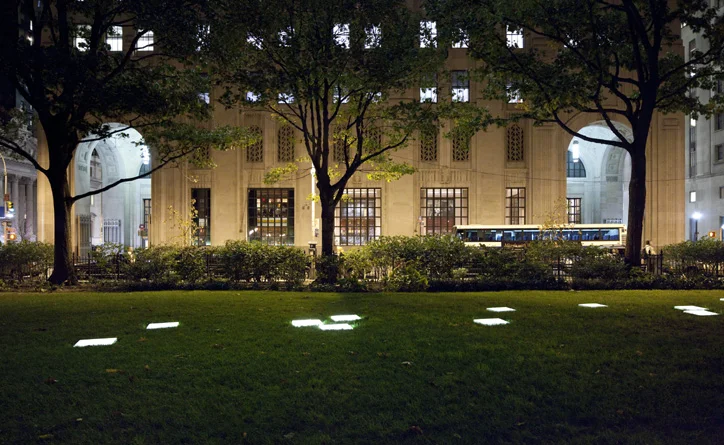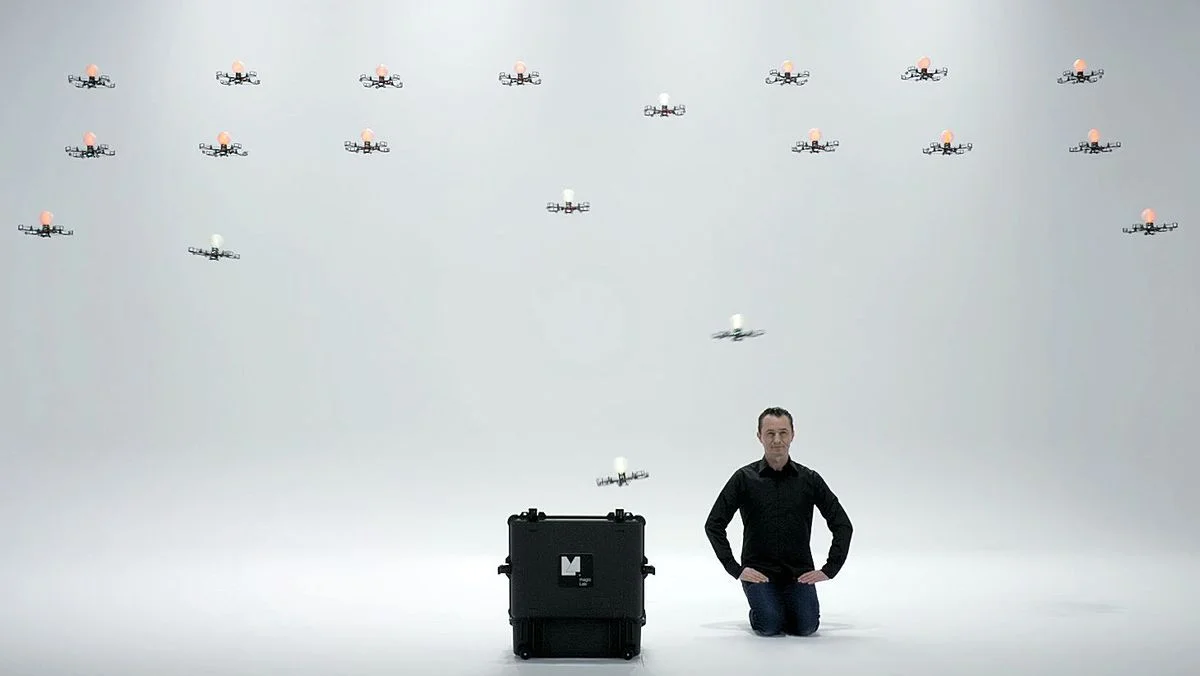Voices In The Subway Station
Voices In The Subway Station is the last of three site-specific installation works Jim Campbell created for the Madison Square Park Conservancy. This public art piece was located on the eastern lawn adjacent to Madison Avenue between 24th and 25th street, which gave the piece a lot of view-ability for public interaction. Once an electrical engineer, Jim Campbell now uses his skills to create art. Using LEDs inside twenty-four glass tablets, Campbell arranged them across this section of the park at ground level. These glass tablets act as a glowing symphony through light and sound design. The rhythm of the light moves in sync with the sounds of the subway. Campbell specifically programmed each tablet to pulse at precise times to create a unique composition with the subway sounds and overlapping conversations heard underground.
The Madison Square Park Conservancy says, “The light pulses emanating from each tablet rhythmically modulate to represent the voices of individual travelers as recorded in conversation on a subway platform, combining to create a visual symphony rendered in light.” Madison Square Park Conservancy, (April 1, 2010) Jim Campbell.
Image from Jim Campbell.
This installation, Voices In The Subway Station, brings to life the eclectic sounds of New York’s common transportation method, the subway. By displaying the light and sounds just above ground, it gives people interacting with the piece the impression that these sounds are coming from underground, and the lights are following the tops of the subway cars themselves.
Art Daily says, “the coordinated pulses create a visual wave of light symbolic of the trademark sounds that mark the progression of subway trains rumbling on arrival only to pass and travel forth, carrying the sounds of commuters with them” Art Daily, (2010), Site-Specific Public Art Instillation By Pioneering New Media Artist Jim Campbell.
Voices In The Subway Station shares a minimal amount of information, that reveals a lot about our culture today, specifically New York City commuter culture. For urbanites, the New York City underground is a common place to find commuters half asleep on their way to work or chatting with colleagues and friends on their way home. Above all though, it might be the best place for people watching. So what would one’s impressions of the subway look like if you remove the visuals and are left with the unique sounds of the subway station? This specifically, is what Jim Campbell’s Voices In the Subway Station explores.
Each tablet in this work only representing a few LED pixels, which gives the impression that a train is passing underneath. Therefore, each tablet in this work acts as a portal to a potential subway station below and leaves the interaction to the audience to imagine what that scene looks like underground. The sounds of this work are specific and precise to give the audience interacting with the work the feeling that they could be at a subway station themselves.
While the sound design of this piece is beautiful, it displays the harsh screeching and loud voices of the subway. Hearing the sounds of the subway while standing in a grassy park, quite literally, brings to light the reality of the subway. This juxtaposition shares the cultural importance of New York City commuter culture because it reveals the difference between traveling above and below the ground and what implications that might have. The subway is the least expensive and fastest mode of transportation, however walking or traveling by car allows a commuter to take in their surroundings and enjoy the unique streets and parks across New York City.
Subway Stories by Alon Chitayat and Jeff Ong is an interactive art piece that allows the audience to interact with the people on the subway. The artists sketched people around them on the subway. These sketches later became the characters in this work after recording their potential thoughts. The end result is a work that allows the audience to move around the subway train and zoom in to listen to the thoughts of various characters on the subway. Like Voices In The Subway Station, this piece also closely examines the conversations and noises of the subway. Conversely, this piece prioritizes the potential internal dialogue of all the people of the subway, rather than the overall chatter and eclectic sounds of the trains themselves. However, both of these works are great representations of New York City commuter culture and the subway system.
Two Trains – Sonification of Income Inequality on the NYC Subway by Brian Foo reveals the incredible highs and lows of New York City’s income inequality through music. Similar to Campbell’s piece Voices In The Subway Station, this work also explores the subway through sonic art. However, the critical content of this piece dives much deeper as it looks for a unique way to display income inequality across the city. The song created in this work takes you on a ride on the 2 train, which is a very diverse route as it takes you through the Bronx, Manhattan, and Brooklyn. Throughout the song, you can identify the income level because the instruments correspond to the median household income of that borough.
Voices In The Subway, Madison Square Art, 2010
Sources:
http://www.jimcampbell.tv/portfolio/public_art/voices_in_the_subway_station/
http://www.madisonsquarepark.org/news/press-releases/jim-campbell






